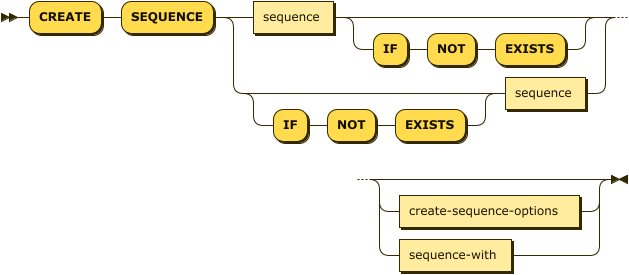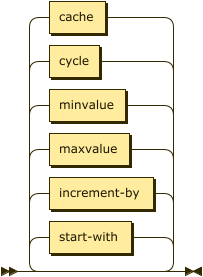CREATE SEQUENCE
- reference
The CREATE SEQUENCE statement enables you to create a sequence in a given scope.
Purpose
A sequence is a construct that returns a sequence of integer values, one at a time, rather like a counter. Each time you request the next value for a sequence, an increment is added to the previous value, and the resulting value is returned. This is useful for generating values such as sequential ID numbers, where you need the Query service to keep track of the current value from one query to the next. You can define any of the following attributes when you create a sequence. You can alter an existing sequence in order to restart it, or to change any of the sequence attributes.
Start Value, Increment, and Direction
By default, a sequence starts at 0 and goes up by 1 at each step.
You can specify the start value of the sequence, the incremental value for the sequence, and the direction of the sequence: ascending or descending.
Maximum and Minimum Value
The highest possible value for a sequence is the highest signed 64-bit integer, 263-1.
This is the default maximum value.
The lowest possible value for a sequence is the lowest signed 64-bit integer, -263.
This is the default minimum value.
You can specify a different maximum or minimum value for a sequence.
Cycling
A sequence may permit cycling. In this case, the sequence behaves as follows:
-
If the sequence is ascending, then when it reaches the maximum value, it continues from the minimum value — which may be different to the sequence’s specified starting value.
-
If the sequence is descending, then when it reaches the minimum value, it continues from the maximum value — which may be different to the sequence’s specified starting value.
If a sequence does not permit cycling, then when it reaches the maximum or minimum value, it generates an error.
Cache
Sequences operate most efficiently with an in-memory cache of values. You can specify the size of this cache when you create the sequence. A block of values is reserved by a node, and requests for values are satisfied from this cache. When exhausted, a new block of values is reserved. Reserving a cached block offers a performance boost, as it enables the Query service to return values directly from memory.
Note however that if a Query node shuts down, or if you alter the sequence, the unused values in the cached block are lost: a new block is reserved when you restart the node, or request the next value. You should choose a cache size with this in mind, along with the expected usage patterns for the sequence.
Storage
Sequences are stored in the bucket’s hidden _system scope.
When you back up a bucket, sequences are included automatically, in accordance with the backup filters.
Similarly, when you restore a bucket, sequences are restored in accordance with the restore command — if you select to restore specific scopes, the sequences associated with those scopes are restored, and no others.
Prerequisites
To execute the CREATE SEQUENCE statement, you must have the Query Manage Sequences privilege granted on the scope. For more details about user roles, see Authorization.
Syntax
create-sequence ::= 'CREATE' 'SEQUENCE' ( sequence ( 'IF' 'NOT' 'EXISTS' )? |
( 'IF' 'NOT' 'EXISTS' )? sequence )
( create-sequence-options | sequence-with )?
The CREATE SCOPE statement provides two possible syntaxes for specifying options for a sequence.
| sequence |
(Required) A name that identifies the sequence within a namespace, bucket, and scope. See Sequence Name below. |
| create-sequence-options |
(Optional) One possible syntax for specifying options for the sequence. See Sequence Options below. |
| sequence-with |
(Optional) The other possible syntax for specifying options for the sequence. See WITH Clause below. |
Sequence Name
sequence ::= ( ( namespace ':' )? bucket '.' scope '.' )? identifier
The sequence name specifies the name of the sequence to create.
Each sequence is associated with a given namespace, bucket, and scope. You must specify the namespace, bucket, and scope to name the sequence correctly.
| namespace |
(Optional) The namespace of the bucket in which you want to create the sequence. |
| bucket |
(Optional) The bucket in which you want to create the sequence. |
| scope |
(Optional) The scope in which you want to create the sequence. |
| identifier |
(Required) The name of the sequence. The sequence name must be unique within the scope. |
Currently, only the default namespace is available.
If you omit the namespace, the default namespace in the current session is used.
If the query context is set, you can omit the bucket and scope from the statement. In this case, the bucket and scope for the sequence are taken from the query context.
The namespace, bucket, scope, and sequence name must follow the rules for identifiers. If the namespace, bucket, scope, or sequence name contain any special characters such as hyphens (-), you must wrap that part of the expression in backticks (` `).
IF NOT EXISTS Clause
The optional IF NOT EXISTS clause enables the statement to complete successfully when the specified sequence already exists.
If a sequence with the same name already exists within the specified scope, then:
-
If this clause is not present, an error is generated.
-
If this clause is present, the statement does nothing and completes without error.
Sequence Options
create-sequence-options ::= ( start-with
| increment-by
| maxvalue
| minvalue
| cycle
| cache )*
You can use the following optional clauses to specify individual attributes for the sequence. These clauses can occur in any order, but none of them can occur more than once in the statement.
| start-with | |
| increment-by | |
| maxvalue | |
| minvalue | |
| cycle | |
| cache |
START WITH Clause
start-with ::= 'START' 'WITH' integer
Use the START WITH clause to specify the starting value for the sequence.
If this clause is omitted, the default start value is 0.
| integer |
(Required) The starting value for the sequence. |
INCREMENT BY Clause
increment-by ::= 'INCREMENT' 'BY' integer
Use the INCREMENT BY clause to specify the increment value of each step in the sequence.
If this clause is omitted, the increment value is 1 — that is, at each step in the sequence, the value goes up by 1.
| integer |
(Required) The step size for the sequence. Use a negative value for a descending sequence. |
MAXVALUE Clause
maxvalue ::= 'MAXVALUE' integer | 'NO' 'MAXVALUE'
Use the MAXVALUE clause to specify the maximum value for the sequence.
Use NO MAXVALUE to specify that the maximum value is the highest signed 64-bit integer, 263-1.
If this clause is omitted, the default is NO MAXVALUE.
| integer |
(Optional) The maximum value for the sequence. |
MINVALUE Clause
minvalue ::= 'MINVALUE' integer | 'NO' 'MINVALUE'
Use the MINVALUE clause to specify the minimum value for the sequence.
Use NO MINVALUE to specify that the minimum value is the lowest signed 64-bit integer, -263.
If this clause is omitted, the default is NO MINVALUE.
| integer |
(Optional) The minimum value for the sequence. |
CYCLE Clause
cycle ::= 'CYCLE' | 'NO' 'CYCLE'
Use the CYCLE clause to specify the whether the sequence should begin again when it reaches the maximum or minimum value.
Use NO CYCLE to specify that the sequence should stop when it reaches the maximum or minimum value.
If this clause is omitted, the default is NO CYCLE.
WITH Clause
sequence-with ::= 'WITH' expr
You can use the WITH clause to specify options for the sequence using a JSON object.
| expr |
(Required) An object with the following properties. |
| Name | Description | Schema |
|---|---|---|
start |
The starting value for the sequence. Default: |
Integer |
increment |
The step size for the sequence. Use a negative value for a descending sequence. Default: |
Integer |
max |
The maximum value for the sequence. If unspecified, the maximum is the highest signed 64-bit integer. Default: |
Integer (int64) |
min |
The minimum value for the sequence. If unspecified, the minimum is the lowest signed 64-bit integer. Default: |
Integer (int64) |
cycle |
Whether the sequence should begin again when it reaches the maximum or minimum value. Default: |
Boolean |
cache |
The cache size for the sequence.
The value must be greater than Default: |
Integer |
Examples
To try the examples in this section, set the query context to the inventory scope in the travel sample dataset.
For more information, see Query Context.
This statement creates a sequence with default attributes in the specified scope.
CREATE SEQUENCE `travel-sample`.inventory.seq1;This statement creates a sequence with default attributes in the current query context, as long as a sequence of the same name does not already exist.
CREATE SEQUENCE seq2 IF NOT EXISTS;This statement creates a sequence starting at 5 and incrementing by 5 each time. When the sequence reaches the maximum value of 1000, it starts again at 0.
CREATE SEQUENCE seq3 IF NOT EXISTS START WITH 5 INCREMENT BY 5 MAXVALUE 1000 MINVALUE 0 CYCLE;The following query tests the sequence.
SELECT NEXT VALUE FOR seq3;The query returns the specified starting value, 5.
[
{
"$1": 5
}
]This statement creates a sequence that starts at 10 and counts down to 0. When it reaches the minimum value, the sequence stops.
CREATE SEQUENCE seq4 IF NOT EXISTS WITH {"start": 10, "increment": -1, "min": 0};The following query tests the sequence.
SELECT NEXT VALUE FOR seq4;The query returns the specified starting value, 10.
[
{
"$1": 10
}
]See Sequence Operators for detailed examples using sequences.
Related Links
-
To alter a sequence, see ALTER SEQUENCE.
-
To drop a sequence, see DROP SEQUENCE.
-
To use a sequence in an expression, see Sequence Operators.
-
To monitor sequences, see Monitor Sequences.
